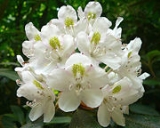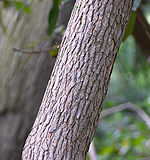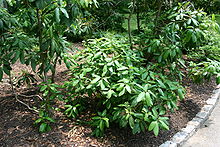
Rhododendron maximum
Encyclopedia
Rhododendron maximum — also called great rhododendron, great laurel, rosebay rhododendron, American rhododendron or big rhododendron — is a species of Rhododendron
native to eastern North America
, from Nova Scotia
south to northern Alabama
.
shrub
growing to 4 m (13 ft), rarely 10 m (33 ft), tall. The leaves
are 9-19 cm (3-8 in) long and 2-4 cm (0.75-1.5 in) broad. The flower
s are 2.5-3 cm (1 in) diameter, white, pink or pale purple, often with small greenish-yellow spots. The fruit
is a dry capsule
15-20 mm (.60-.79 in) long, containing numerous small seed
s. The leaves can be poisonous. Leaves are sclerophyllous, simple, alternate, and oblong (10 to 30 cm long, 5 to 8 cm wide). It retains its waxy, deep-green leaves for up to 8 years, but once shed are slow to decompose. It produces large, showy, white to purple flowers each June.
hill-slopes throughout the upper Piedmont Crescent of the Southeastern United States.
 Approximately 12,000 square kilometres in the southern Appalachians are occupied by this species (Dobbs 1995) where it dominates the understory. This species has historically been confined to riparian areas and other mesic sites but takes advantage of disturbed areas where it is present to advance onto sub-mesic sites. It prefers deep well-drained acid soils high in organic matter where it produces a thick, peat-like humus. It prefers low to medium light conditions for optimum carbon gain, and has a tremendous capacity for avoiding cavitation during freeze-thaw cycles (Lipp and Nilsen 1997). Where extensive overstory mortality has eliminated most of the overstory, this species forms a thick and continuous subcanopy known locally as ‘laurel slicks’ or ‘laurel hells’. Rosebay rhododendron is an important structural and functional component of southern Appalachian forest ecosystems. What isn’t clear is whether or not we are in a period of advancement or retreat for this species. For example, on poorly drained sites on ridge or upper slope positions, large areas of rosebay rhododendron, particularly at the high elevations, have recently died out presumably due to the phytophthora fugus, or due to recent prolonged periods of below-average precipitation. Yet, rosebay rhododendron now occupies sites that historically were free of evergreen understory. There are still important questions to be answered regarding this species to completely understand its role in forest understories.
Approximately 12,000 square kilometres in the southern Appalachians are occupied by this species (Dobbs 1995) where it dominates the understory. This species has historically been confined to riparian areas and other mesic sites but takes advantage of disturbed areas where it is present to advance onto sub-mesic sites. It prefers deep well-drained acid soils high in organic matter where it produces a thick, peat-like humus. It prefers low to medium light conditions for optimum carbon gain, and has a tremendous capacity for avoiding cavitation during freeze-thaw cycles (Lipp and Nilsen 1997). Where extensive overstory mortality has eliminated most of the overstory, this species forms a thick and continuous subcanopy known locally as ‘laurel slicks’ or ‘laurel hells’. Rosebay rhododendron is an important structural and functional component of southern Appalachian forest ecosystems. What isn’t clear is whether or not we are in a period of advancement or retreat for this species. For example, on poorly drained sites on ridge or upper slope positions, large areas of rosebay rhododendron, particularly at the high elevations, have recently died out presumably due to the phytophthora fugus, or due to recent prolonged periods of below-average precipitation. Yet, rosebay rhododendron now occupies sites that historically were free of evergreen understory. There are still important questions to be answered regarding this species to completely understand its role in forest understories.
, competition for resources including light, physical and chemical attributes of the forest floor and soil, and interactions between some or all sources (Nilsen et al. 1999, Nilsen et al. 2001).
Rhododendron
Rhododendron is a genus of over 1 000 species of woody plants in the heath family, most with showy flowers...
native to eastern North America
North America
North America is a continent wholly within the Northern Hemisphere and almost wholly within the Western Hemisphere. It is also considered a northern subcontinent of the Americas...
, from Nova Scotia
Nova Scotia
Nova Scotia is one of Canada's three Maritime provinces and is the most populous province in Atlantic Canada. The name of the province is Latin for "New Scotland," but "Nova Scotia" is the recognized, English-language name of the province. The provincial capital is Halifax. Nova Scotia is the...
south to northern Alabama
Alabama
Alabama is a state located in the southeastern region of the United States. It is bordered by Tennessee to the north, Georgia to the east, Florida and the Gulf of Mexico to the south, and Mississippi to the west. Alabama ranks 30th in total land area and ranks second in the size of its inland...
.
Description
R. maximum is an evergreenEvergreen
In botany, an evergreen plant is a plant that has leaves in all seasons. This contrasts with deciduous plants, which completely lose their foliage during the winter or dry season.There are many different kinds of evergreen plants, both trees and shrubs...
shrub
Shrub
A shrub or bush is distinguished from a tree by its multiple stems and shorter height, usually under 5–6 m tall. A large number of plants may become either shrubs or trees, depending on the growing conditions they experience...
growing to 4 m (13 ft), rarely 10 m (33 ft), tall. The leaves
Leaf
A leaf is an organ of a vascular plant, as defined in botanical terms, and in particular in plant morphology. Foliage is a mass noun that refers to leaves as a feature of plants....
are 9-19 cm (3-8 in) long and 2-4 cm (0.75-1.5 in) broad. The flower
Flower
A flower, sometimes known as a bloom or blossom, is the reproductive structure found in flowering plants . The biological function of a flower is to effect reproduction, usually by providing a mechanism for the union of sperm with eggs...
s are 2.5-3 cm (1 in) diameter, white, pink or pale purple, often with small greenish-yellow spots. The fruit
Fruit
In broad terms, a fruit is a structure of a plant that contains its seeds.The term has different meanings dependent on context. In non-technical usage, such as food preparation, fruit normally means the fleshy seed-associated structures of certain plants that are sweet and edible in the raw state,...
is a dry capsule
Capsule (fruit)
In botany a capsule is a type of simple, dry fruit produced by many species of flowering plants. A capsule is a structure composed of two or more carpels that in most cases is dehiscent, i.e. at maturity, it splits apart to release the seeds within. A few capsules are indehiscent, for example...
15-20 mm (.60-.79 in) long, containing numerous small seed
Seed
A seed is a small embryonic plant enclosed in a covering called the seed coat, usually with some stored food. It is the product of the ripened ovule of gymnosperm and angiosperm plants which occurs after fertilization and some growth within the mother plant...
s. The leaves can be poisonous. Leaves are sclerophyllous, simple, alternate, and oblong (10 to 30 cm long, 5 to 8 cm wide). It retains its waxy, deep-green leaves for up to 8 years, but once shed are slow to decompose. It produces large, showy, white to purple flowers each June.

Range
Worldwide, there are over 800 species in the genus Rhododendron. Most of the 26 North American species occur in the East along the mountain chain stretching from Nova Scotia in the north to Georgia and Alabama in the south, but are concentrated in the southern Appalachians (Dobbs 1998). Rosebay rhododendron is the most frequently occurring and dominant species of this genus in the southern Appalachian region (Swanson 1994), and occurs occasionally on mesicMesic habitat
In ecology, a mesic habitat is a type of habitat with a moderate or well-balanced supply of moisture, e.g., a mesic forest, a temperate hardwood forest, or dry-mesic prairie. Compared to a dry habitat, a mesic habitat is moister....
hill-slopes throughout the upper Piedmont Crescent of the Southeastern United States.
Ecology

Reproduction
Rosebay rhododendron is clonal. It is capable, however, of reproducing both vegetatively and sexually. It reproduces vegetatively through a process called ‘layering’ where it produces roots from above ground woody parts when in contact with the forest floor. The fruit is produced from showy flowers from March to August. The fruit is an oblong capsule that ripens in the fall, and splits along the sides soon after ripening to release large numbers of minute seed (approx. 400 per capsule) (Schopmeyer 1974). Microsite requirements for seed germination are relatively specific (e.g., high in organic matter such as rotting logs); hence, the majority of reproduction is vegetative resulting in a clonal distribution.Growth and management
Seeds from rosebay rhododendron are minute and it is estimated that approximately 11 million are contained in 1 kg. Commercial seed production is generally from cultivated hybrids. Seeds from wild sources are not commonly sold commercially. Rosebay rhododendron is a slow-growing shrub and has a very high sprout potential. If mechanical removal is attempted in the case of forest management, extremely high densities are attained by this species in a manner of a few years. Prescribed fire has also been used to control this species but with limited success (Clinton and Vose 2000).Benefits
Rosebay rhododendron is a striking and aesthetically pleasing feature of mesic southern Appalachian forests. It is one of the largest and hardiest rhododendrons grown commercially. Several cultivars with white to purple flowers have been selected for the horticultural trade (Brown and Kirkman 1990). Where it occurs naturally, it produces a showy, white, pink, or light purple flower primarily in June, but occurs from March into August. Rosebay rhododendron maintains deep-green foliage year round. This species affords protection to steep watersheds and shelter for wildlife. The wood is very hard and is occasionally used for specialty wood products.Detrimental effects
For all its prized qualities as a naturally occurring component of the landscape or as plantings in residential and commercial landscaping, rosebay rhododendron can have an inhibitory effect on regeneration of other plant species. There is some evidence to suggest that due to fire suppression and the absence of other cultural activities (i.e., mountain-land grazing), this species has advanced beyond the mesic forest sites into sub-mesic understories (Dobbs 1998). The significance of this movement onto previously unoccupied sites centers around the impacts of rosebay rhododendron on plant succession (Clinton and Vose 1996) and resource availability (Nilsen et al. 2001). Rosebay rhododendron is associated with reduced woody and herbaceous seedling abundance throughout its range, and hence poses a serious impediment to the production of wood products. The mechanism(s) by which rosebay rhododendron reduces seedling survival has been the subject of much debate. Possible sources of inhibition include allelopathyAllelopathy
Allelopathy is a biological phenomenon by which an organism produces one or more biochemicals that influence the growth, survival, and reproduction of other organisms. These biochemicals are known as allelochemicals and can have beneficial or detrimental effects on the target organisms...
, competition for resources including light, physical and chemical attributes of the forest floor and soil, and interactions between some or all sources (Nilsen et al. 1999, Nilsen et al. 2001).
Alternate common names
R. maximum has also been called:- Great Rhododendron
- Late Rhododendron
- Summer Rhododendron
- Great Laurel
- Bigleaf Laurel
- Deertongue Laurel
- Rose Tree
- Rose bay
- Bayis
- Mountain Laurel

